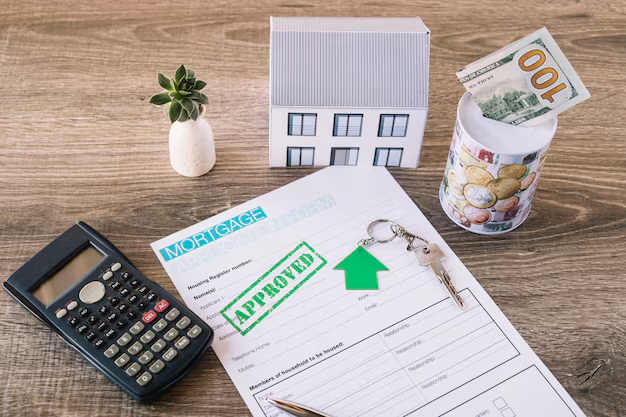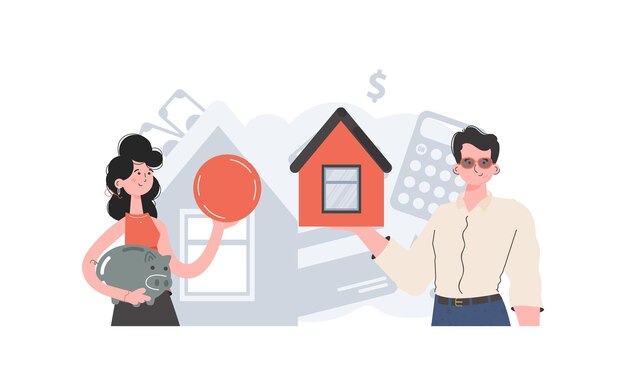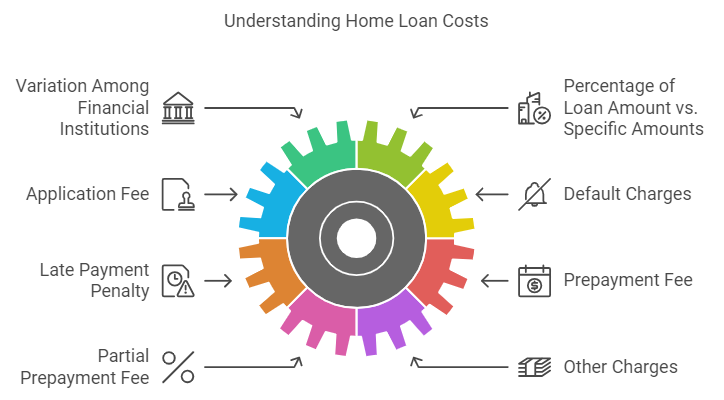Securing a housing loan involves several financial considerations, one of the most crucial being the processing fees. These upfront costs can be surprisingly hefty, and comprehending their full impact might lead to unpleasant surprises and budget miscalculations later on.
Hence, it is safe to say that knowing about the housing loan processing fees and the required documentation can equip you with the necessary knowledge to navigate this complex terrain, and in this article, we will do precisely that.
However, that is not all. In addition to explaining how these fees are structured, we will introduce you to additional charges that could arise later and highlight a checklist of essential documents that will ensure you are well-prepared for a smooth application process in the Philippines.

What is a Housing Loan, And Why is it Important?

A housing loan, also known as a home loan or mortgage, is a type of loan used to finance a property's purchase, construction, or renovation. Borrowers receive a lump sum to buy a home, which is repaid in installments over a set period, typically ranging from 10 to 30 years, with interest.
The importance of a housing loan in the Philippines is as follows -
- Homeownership Accessibility: Housing loans allow individuals to purchase a home without needing full upfront payment, making homeownership more attainable.
- Long-Term Investment: Real estate is a long-term asset that typically appreciates in value, making it a sound financial investment.
- Tax Benefits: In some cases, home loan borrowers can benefit from tax deductions on loan interest, which reduces their taxable income.
- Build Equity: As you repay the loan, you build equity in your home, increasing your financial security and asset portfolio over time.
- Financial Flexibility: Housing loans offer flexible repayment terms, allowing individuals to choose a loan that fits their economic capacity.
Also Read: Types of Collateral for Secured Business Loans
Importance of Housing Loan Processing Fees and Required Documents
When you're considering taking out a housing loan in the Philippines, one of the first things you'll encounter is the processing fee. This fee can add a considerable amount to the overall cost of the loan, making it crucial for borrowers to grasp its significance.
Processing fees cover various charges levied by lenders to manage the loan application process, such as administrative costs, credit checks, and legal services.
Home Loan Processing Fees
1. Payment and Timing
One important thing to note is that borrowers usually pay these fees upfront. This means you pay them separately from the loan amount, often before the loan is disbursed.
Lenders generally set the processing fee as a percentage of the total loan amount, typically 0.5% to 1% plus any applicable taxes.
For example, if you're taking out a PHP 200k home loan, your processing fees could range from PHP 1k to PHP 2k. This charge is not deducted from the loan amount but is an extra cost you need to budget for.
2. Components of Processing Fees
So, what makes up this fee? The processing fee usually includes the following elements -
- Document Verification Charges: This covers the cost of verifying your records and paperwork.
- Credit Checks: Determining your creditworthiness through credit score evaluations.
- Appraisal Fees: Valuing the property you're planning to purchase or mortgage.
- Underwriting Costs: The lender incurs expenses for underwriting your loan.
- Legal and Valuation Fees: Cover the legal processes and property valuation.
- Technical Fees: These include credit report checks and further document verification costs.
3. Post-Approval Charge
Interestingly, lenders charge the processing fee after they have approved your loan application, not before. Your loan approval depends on various factors, such as your eligibility to repay the loan, your credit score, income, job type, and any other outstanding loans you might have.
4. Potential Variations and Exemptions
Processing fees can vary depending on the lender, the type of loan, and the borrower's specific circumstances. Some lenders might even waive these fees for special promotions or offers. Therefore, shopping around and comparing before selecting is always a good idea.
Required Documentation Checklist
1. Duly Accomplished Loan Application Form - Completed form provided by the bank or lender.
2. Valid Government-Issued ID - Passport, driver’s license, or other valid ID.
3. Proof of Income - For the employed, the Latest payslips, Certificate of Employment, and Income Tax Return (ITR) are required. Business permits, audited financial statements, and ITR are also necessary for the self-employed.
4. Proof of Billing - Utility bills (electricity, water, or internet) showing your current address.
5. Marriage Contract (if applicable) - For married applicants, a certified copy of the marriage contract.
6. Tax Identification Number (TIN)
7. Copy of the Property’s Title - Certified true copy of the Transfer Certificate of Title (TCT) or Condominium Certificate of Title (CCT).
8. Notarized Contract to Sell or Reservation Agreement
9. Bank Statements - Typically, the last three to six months of your bank statements.
10. Appraisal Fee (if required) - Paid upfront to cover the property appraisal process.
Are you unclear on the requirements for applying for a home loan with Pag-ibig in the Philippines? Here, check out this video. It clearly highlights the specific requirements that will assist you in getting the loan you require.
Also Read: Getting a Small Business Loan in The Philippines
Seize growth opportunities with N90’s fast financing solutions. Apply now and get potential loan approvals within 24 hours! Empower your Philippine SME with the capital it needs to succeed today!
Key Details of Processing Fees Charged by Banks
The landscape regarding housing loan processing fees can vary greatly, depending on the type of loan, bank policies, and the loan amount the borrower avails.
Hence, it is crucial to understand the details of these fees carefully. They contribute to the overall cost of borrowing, and being aware of them can help borrowers make the right financial decisions when selecting a loan provider in the Philippines.
Here, take a look at the critical details that determine the processing fees charged by banks when applying for a home loan in the Philippines -

1. Variation Among Financial Institutions
Different lenders have varying processing fees, and this variation can be attributed to several factors, including the type of borrower. Salaried individuals often benefit from lower processing fees than self-employed professionals (SEPs) and self-employed non-professionals (SENPs).
This discrepancy arises due to the perceived risk and the extra paperwork involved in verifying the income sources of self-employed individuals, especially those with lower credit scores.
2. Percentage of The Loan Amount Vs. Specific Amounts
Processing fees can be applied either as a percentage of the loan amount or as a fixed sum. For instance, while one bank might charge 0.5% of the total loan amount, another might demand PHP 10k as a flat fee.
Doing so creates a challenging scenario for borrowers, who must balance lower processing fees and other factors, like interest rates, that influence the total cost of the loan.
Interestingly, these processing fees are often negotiable, as lenders sometimes may agree to lower rates for borrowers with excellent credit scores or long-standing relationships with the bank. These non-refundable fees can vary widely, and comparing them with interest rates can help you select a cost-effective option.
Also Read: DTI in Tagalog: National Action Plan and SMEs Sales Record
Additional Home Loan Charges
When you enter the world of home loans, various additional fees await you beyond the basic processing fees. Understanding these costs is crucial to avoid any surprises down the line.
1. Application Fee
The application fee is a one-time, non-refundable amount you pay at the start of the loan application process. It covers the lender's costs for reviewing your loan request.
2. Default Charges
Default charges come into play if you fail to repay your loan on time. These fees cover the administrative costs of handling a missed payment and include an extra penalty to discourage late payments.
3. Late Payment Penalty
If you miss an EMI (Equated Monthly Installment) payment, you will incur late payment penalties. These penalties usually range from 2% to 3% of the missed EMI amount, adding another layer of responsibility to timely payments.
4. Prepayment Fee
Some loans allow you to repay the loan earlier than scheduled, but this often comes with a prepayment fee. This charge compensates the lender for the interest income they lose due to the early repayment.
5. Partial Prepayment Fee
Like the prepayment fee, the partial prepayment fee is applied when you make more significant payments than your regular EMI but still need to settle the loan entirely. This fee occurs because such payments affect the lender's expected interest income.
6. Other Charges
Additional miscellaneous charges may apply, such as insurance premiums, switching fees (for changing the terms of your loan), and administrative or legal fees. Each can add up, so factoring them into your overall cost calculations is essential.
Navigating these fees might seem overwhelming, but knowing them can help you make an informed decision and better manage your finances during the home loan process.
Also Read: Understanding the Features, Importance, and How Microfinance Works
Document-related Fees
Understanding the various document-related fees can help you better prepare financially when securing a housing loan.
Here's a breakdown of some standard charges you might encounter -
1. Stamping Fee
Stamping fees come into play while signing legal documents associated with your loan. These fees vary depending on the state and are usually either a percentage of the loan amount or a fixed rate.
For instance, in the Philippines, the stamp duty on loan documents typically exceeds 0.15% of the loan amount. It’s a necessary cost to formalize your mortgage agreement legally.
2. Charges For Certificates and Reports
Lenders often require a range of certificates and reports as part of loan processing. These include IT certificates, interest certificates, and credit scores, which are essential in assessing your creditworthiness and the financial viability of the loan.
Essentially, these document fees cover the administrative costs of producing these reports.
3. Document Retrieval Charges
After you've paid off your loan, you’ll need to retrieve the original documents tied to your home or property. Lenders impose retrieval charges when they hand back these vital documents. So, it is a good idea to anticipate this fee when budgeting for the end of your loan term.
4. Fees For Copies and Schedules
You may need additional copies of your loan documents or financial statements during your loan tenure. Fees apply for obtaining copies of agreements, loan statements, and amortization schedules.
5. Legal and Technical Fees
Lenders often charge fees for the legal and technical evaluation of property. These fees cover the cost of lawyers and technical experts who review your property documents to ensure everything is in order.
6. Stamp Duty and Registration Fees
The government typically mandates these fees, which can vary from region to region. They are required for the legal documentation and registration of your loan agreement.
7. Administrative Fees
Some lenders may charge an administrative fee for handling and processing your documents. This can also include charges for document verification and storage.
8. Miscellaneous Fees
Miscellaneous documentation charges may apply, such as notarization, photocopying, and courier fees.
Conclusion
Understanding the processing fees and preparing the necessary documents are critical steps in applying for a housing loan. As this article clearly explains, while processing fees are an additional cost, they ensure your application's swift and accurate handling.
Additionally, borrowers can further streamline the loan process and avoid unnecessary delays by preparing all required documents, such as valid IDs, proof of income, and property details.
It is also worth noting that although processing fees are generally non-refundable, they can sometimes be negotiated, especially for borrowers with a strong credit history. Some lenders may also offer refunds or waivers under specific conditions.
To conclude, it is a good idea always to review the terms and conditions carefully to avoid hidden charges. Being aware of potential fee waivers and refund policies can also benefit you. With thorough research and professional guidance, you can optimize your home loan experience and ensure it aligns with your financial goals.
Frequently Asked Questions (FAQs)
1. What are the requirements for in-house financing in the Philippines?
In-house financing in the Philippines typically requires the following -
- Valid ID (e.g., passport, driver’s license)
- Proof of Income (e.g., payslips, employment certificate, or ITR for self-employed)
- Proof of Billing (e.g., utility bills)
- Reservation Fee (for the property)
- Signed Purchase Agreement with the developer
2. What is the income requirement for a home loan in the Philippines?
The income requirement for a home loan in the Philippines typically depends on the lender and the loan amount. Generally, banks require a minimum monthly income of PHP 30k to PHP 50k for individual borrowers.
The minimum monthly income for government-backed loans like Pag-IBIG can be as low as PHP 15k as lenders assess income to ensure the borrower’s repayment capacity.
3. How long is home loan approval in the Philippines?
Home loan approval in the Philippines can typically take anywhere from a couple of weeks to 6 months, but this timeline can vary depending on the lender and the completeness of the required documents.
Banks may take longer due to their strict processes, while government-backed loans like Pag-IBIG may also require additional time for verification.
4. How much deposit do I need to buy a house in the Philippines?
Most lenders require a down payment of 10% to 20% of the property’s purchase price to buy a house in the Philippines. For example, if the house costs PHP 2 million, you’ll need to deposit PHP 200k to PHP 400k.
Some developers offering in-house financing may require lower down payments, while Pag-IBIG loans, depending on the property, allow for minimal deposits.













